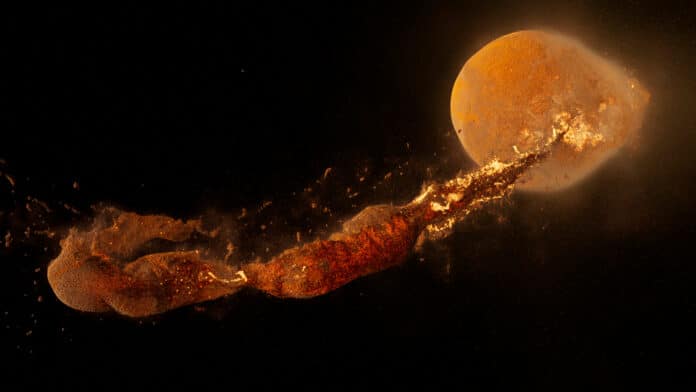The Moon is traditionally thought to have coalesced from the debris ejected by a giant impact onto the early Earth. Scientists have spent decades figuring out how precisely that formation occurred without a clear solution.
A new simulation puts forth a different theory – the Moon may have formed immediately, in a matter of hours, when Earth’s and Theia’s material was launched directly into orbit after the impact.
Jacob Kegerreis, a postdoctoral researcher at NASA’s Ames Research Center in California’s Silicon Valley, said, “This opens up a whole new range of possible starting places for the Moon’s evolution. We went into this project not knowing exactly what the outcomes of these high-resolution simulations would be. So, on top of the big eye-opener that standard resolutions can give you misleading answers, it was extra exciting that the new results could include a tantalizingly Moon-like satellite in orbit.”
The simulations employed in this study are among the most detailed of their kind and operate at the highest resolution of any simulation done to investigate the Moon’s formation or other giant impacts. Access to more computational power allowed researchers to see novel behaviors arise in a way that earlier studies simply could not.
It’s less likely that we would observe such high parallels in earlier scenarios where Theia was blown out into orbit and mixed with only a small amount of material from Earth unless Theia was likewise isotopically similar to Earth, an unusual coincidence. According to this hypothesis, the Moon was formed mostly from Earth’s material, which could help to explain why its outer layers are comparable to the Earth’s.
Other theories have been proposed to explain these similarities in composition, such as the synestia model – where the Moon is formed inside a swirl of vaporized rock from the collision – but these arguably struggle to explain the Moon’s current orbit.
This single-stage, quicker formation hypothesis provides a clearer and more elegant answer to both open questions. It might also offer fresh approaches to solving other riddles that haven’t been solved. One of the more intriguing theories for the formation of the Moon is this one, which might put the Moon into a wide orbit with an interior that isn’t molten, thus explaining features like the Moon’s tilted orbit and thin crust.
Analyzing upcoming moon samples that NASA’s future Artemis missions will return to Earth for investigation will help us determine which of these possibilities is true. Scientists will be able to assess how real-world data stacks up to these simulated scenarios and what they reveal about how the Moon has changed over its billions of years of history as they acquire access to samples from other regions of the Moon and deeper beneath its surface.
Vincent Eke, a researcher at Durham University and a co-author of the paper, said, “The more we learn about how the Moon came to be, the more we discover the evolution of our own Earth. Their histories are intertwined – and could be echoed in the stories of other planets changed by similar or very different collisions.”
This research is a collaborative effort between Ames and Durham University, supported by the Institute for Computational Cosmology’s Planetary Giant Impact Research group. The simulations used were run using the open-source SWIFT (SPH with Inter-Dependent Fine-grained Tasking) code, carried out on the DiRAC (Distributed Research Utilizing Advanced Computing) Memory Intensive service (“COSMA”), hosted by Durham University on behalf of the DiRAC High-Performance Computing facility.
Journal Reference:
- J. A. Kegerreis et al. Immediate Origin of the Moon as a Post-impact Satellite. The Astrophysical Journal Letters. DOI: 10.3847/2041-8213/ac8d96
